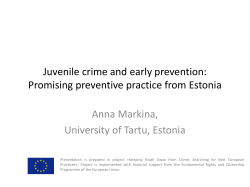
National Prevention Science Coalition to Improve Lives
April 16, 2015 The National Prevention Science Coalition to Improve Lives (NPSC) formed to improve the chances for all children and adolescents to lead healthy, successful lives and for our families and communities to thrive. We promote the prevention of problems through the implementation of scientifically validated measures to improve mental health and reduce risk. We therefore strongly oppose the indiscriminate shackling of youth in juvenile courtrooms as this practice is harmful to young people and likely to increase recidivism and inhibit rehabilitation. In most states, there are no laws protecting young people from being shackled in juvenile court. Indeed, shackling—being placed in handcuffs, leg irons, and/or belly chains—is standard procedure in the majority of courtrooms across the country. It is not only standard, but automatic. That is, children coming from detention or residential facilities are shackled without regard for their age, size, risk to themselves or others, or history. Most juvenile charges, it should be noted, are misdemeanors--relatively minor in nature. Jurisdictions that have done away with indiscriminate juvenile shackling report that they do not have subsequent problems with escapes or with violent outbursts in the courtroom. Hence, this practice serves no positive purpose. The science of adolescent brain development has significantly advanced in this century. Neuroscientific studies have guided U.S. Supreme Court rulings through consistent findings of deficits and development delays in neurological regulatory systems of young people caught up in our justice system. Moreover, there is strong support for the potential for adolescents who have committed crimes to be rehabilitated. Children and adolescents are far more susceptible to environmental influences than adults due to a high level of brain plasticity. The juvenile court was originally intended to be a rehabilitative environment. However, placing young people in handcuffs, leg irons and belly chains runs counter to this end. Teenagers who have endured this experience speak of feeling like criminals, slaves, and animals. When individuals are treated with disrespect and their lives are not valued, they begin to view themselves as such, increasing the likelihood that they will succumb to these negative influences. This is the process by which identity development occurs in these formative years. Within the juvenile justice system, up to 90 percent of youth report exposure to a traumatic event, according to a 2013 national study. On average, 70 percent of youth meet criteria for a mental health disorder with about 30 percent meeting criteria for post-traumatic stress disorder (PTSD).1 Shackling is a distressing experience likely to exacerbate, if not contribute to, PTSD and other mental illnesses. Most people who are trauma survivors or who have mental illness will never get in trouble with the law. Indeed, they are more likely to be victims of crime than perpetrators. But trauma often undermines coping skills, leading to heightened or maladaptive responses to perceived dangers. These behaviors may make a youth seem more combative in court, even when this is not the reality. Moreover, when the court adds to the traumatic experience of a young person, it increases the likelihood that he or she will be arrested again. 1 Available http://www.ejpt.net/index.php/ejpt/article/view/20274 Young people are more likely to comply with the court’s instructions and gain respect for the law when they perceive that they themselves have been treated fairly and respectfully. Several national studies have documented this effect. It is hardly fair to shackle all children where the presumption of innocence is meant to protect them. Adults, on the other hand, are protected from shackling in the courtroom unless they pose some extraordinary risk that cannot be managed through less draconian measures. Young people are particularly vulnerable and deserve more protection in our courts, not less. They are more likely to suffer lasting consequences from the experience of being bound in chains and appearing in shackles before family and strangers alike. Finally, research clearly shows that most people who break the law as adolescents will not continue to do so into adulthood. This is called “aging out” of crime. The juvenile justice system was designed to facilitate rehabilitation. The very least that the system should do is to refrain from disrupting the prosocial development that occurs naturally as humans mature. The humiliating nature of shackling and its profound effect on young people at a critical stage of identity development undermine the mission of the juvenile justice system. The NPSC is comprised of scientists (across disciplines), educators, community stakeholders, practitioners and clinicians, policymakers, advocates, and foundation representatives. We share a commitment to improving the lives of children in many contexts, and particularly those involved in the juvenile justice system. There is no objective evidence that shackling serves a necessary function in the juvenile court. There is ample evidence that it harms young people and undermines the rehabilitative mission of the juvenile court. Shackling should be a most rare event in the juvenile court and should happen only after substantial proof is produced that mechanical restraints are the sole viable option to preserve safety. Respectfully, Diana Fishbein, Ph.D.
© Copyright 2025















